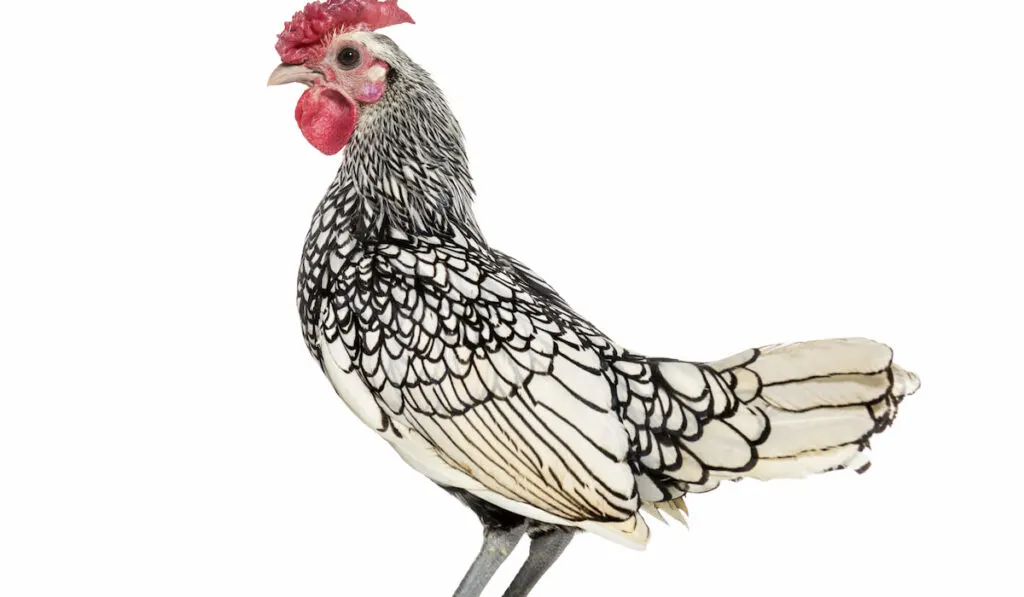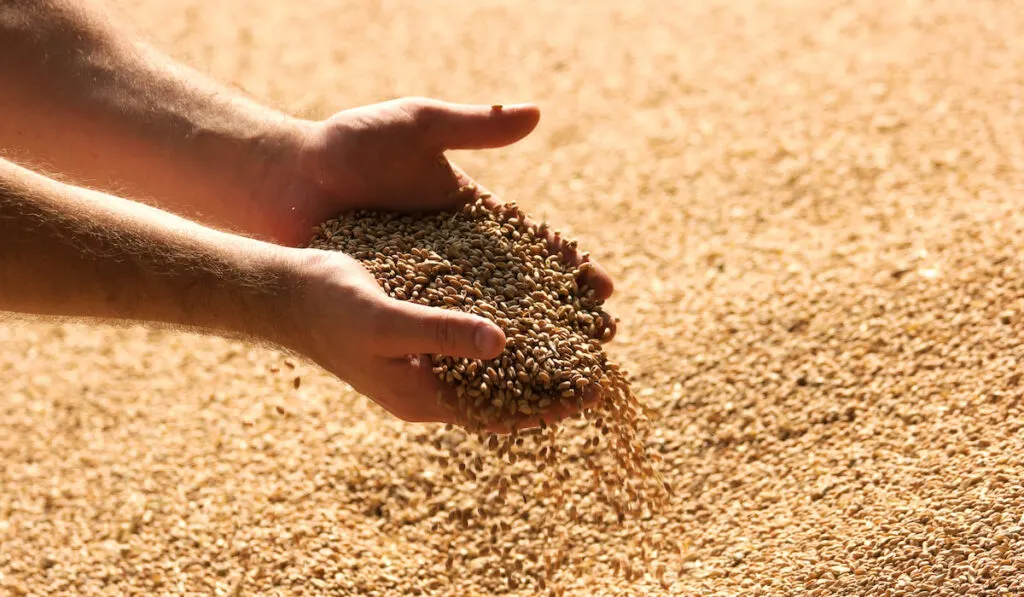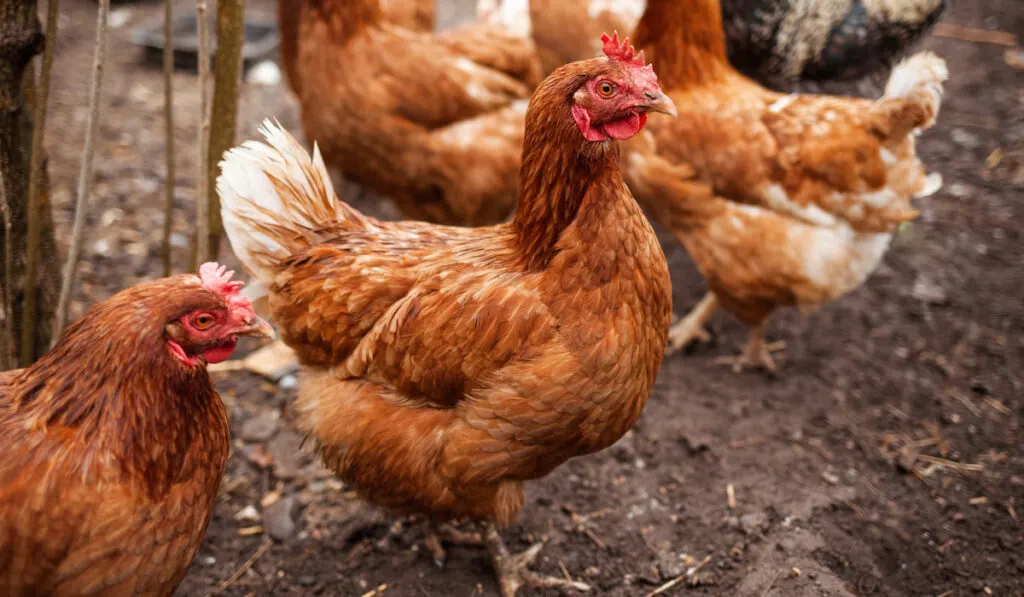Bantam chickens are a lovely breed. They are friendly, docile, adorable, and they have prominent personalities for such small birds.
They are also perfect for small gardens because they vary from 1 third to ½ the size of a regular chicken. They are the miniature versions of regular sized chickens and there are 400 different types of bantam breeds.

These include:
- Developed Bantam – These birds are small and were developed by man.
- True Bantam – These bantams are not bred by humankind and are 100% natural. Rose Comb, Sebright and Nankin are all examples of true bantams.
- Miniature Bantam – This breed of Bantam was bred by humankind and is more miniature versions of Orpingtons, Cochin, Rode Island Red and many more.
Table of Contents
How To Care For Your Bantam Chickens
Space & Environment
Bantam Chicken require a minimum of 1 square foot per bird; however, Bantams kept in 2 square feet per bird enclosures are reported to be calmer and more docile.
Bantam chickens love to fly and rest on different heights perches, so make sure that the coop is high enough with plenty of perches. If you place bushes and small trees in their enclosure, your chickens will be pleased.
Their coop also needs to be protected from any drafts, and it always needs to be dry. Bantams have a fast metabolism, so they are more susceptible to the cold than regular chickens.
Food & Nutrition
Bantam chickens only eat a third of the amount of the food of regular chickens. They need calcium, grit, electrolyte powder and vitamins. Clean water should always be available to these chickens.
If you do not feed your Bantams a healthy and nutritious diet, it could lead to the following;
- Eggs that are deformed
- Their egg production will decrease.
- They will start picking at their feathers.
- Their behavior starts to change negatively.
- They are more prone to diseases.
- Their lifespan gets shorter.
Foods That Are Good For Bantam Chickens

- Chicken Pellets containing maize, sunflower seeds, wheat, salt and raw oats. All these ingredients are compressed into edible-sized pellets. Purina Layena Nutritionally Complete Layer Hen Feed and Manno Pro Layer Pellets For Chickens are examples of excellent food for chickens. These pellets are formulated with enough minerals and protein, which are essential to good egg-laying.
- Potato skins
- Wheat & Corn Grains
- Carrots
- Apple Cores
- Vegetable Skins
- Broccoli
- Bananas
- Pumpkin
- Mealworms
- Dried Mealworms
- Kitchen Scraps such as wholewheat bread, pasta, rice, fruit, vegetables, porridge, etc., make great snacks for chickens. Remember to cut any food into small pieces before feeding it to your chickens.
Foods That Are Bad For Bantam Chickens
- Crisps
- Rhubarb
- Avocado
- Chocolate (any sweets)
- Garlic
- Onions
- Heavily processed foods
You can feed your chickens many more foods, but make sure they are all low in sugar and salt. You only need to provide food for your chickens once in the morning and once in the evening. Their pellets can be sprinkled on the floor or placed in a chicken trough.
Remember that if you decide to feed your chickens straight on the ground, make sure there are no droppings. If your chickens were to ingest any droppings accidentally, they could get coccidiosis or parasitic infections.
You should monitor how much food your birds eat to adjust the amount accordingly. If you notice that there are pellets leftover in the trough by evening time, then you are feeding them too many pellets.
Free-range chickens don’t overeat; they will only eat what they need and will leave the rest.
Regular chickens tend to eat all the food that you feed to them but never leave any pellets out overnight. They will become soggy and could attract unwanted pests.
Make sure all your chickens are getting enough food. Separate the dominant ones from the weaker chickens; otherwise, the weak ones will starve and get sick.
15 Different Types Of Bantam Chickens
There are many varieties of bantam chickens. Below is a table to show the differences between the different bantam breeds.
| Breed | Size | Egg Laying | Place of Origin | Color | Temperament |
| Araucana | 1.5-1.9lbs | GoodBlue shells | Araucana Region Of Chile | BlackWhiteSilver DuckwingGolden DuckwingBlack Breasted Red | DocileGentleCalmEnjoys free-range & confinement |
| Brahma | 2-2.2lbs | Good150 Annually | America-1850s | BuffDarkLight | DocileGentleEasily trainedCalm |
| Chantecler | 1.9-2.2lbs | ExcellentBrown200+ Annually | Montreal-1920s | WhitePartridge | Docile CalmSkittish at times |
| Leghorn | 2-2.2lbs | ExcellentWhite280 Annually | Tuscany, Central Italy-1800 | Rose Comb – dark brown, light brown, buff, black, silverSingle Comb – White, Columbian, red, dark brown, barred, black-tailed red | Prefers free-rangeDislike’s confinementShySkittishNervous |
| Malay | 2.2-2.5lbs | GoodBrown180 Annually | England-1830 | BlackRedWhiteTan | Dislike’s confinementPrefers free-rangeCan be aggressiveDo not mix well with other flocks |
| Serama (smallest bantam breed in the world) | 0.45-1.3lbs | GoodWhite, deep brown120 Annually | Malaysia-1600s | Brown-redBlackBlue-redWhitebrown | DocileGentleCalmFriendlyAt times skittish |
| Booted | 1.3-1.8lbs | GoodWhite150-180 Annually | Netherlands | Self-blueMottledBuffBarredCuckooGolden neckLemon Mille FleurSilver Mille FleurPartridgeLavender | DocileCalmFriendlySweetEasily tamed |
| Silkie | 1.8-2.2lbs | GoodCream, tinted100 Annually | China-1874 | BlackBlueGreySplashWhiteStandard buff | DocileCalmFriendly |
| Sultan | 1.3-1.8lbs | PoorWhite70 Annually | Turkey-1854 | BlackBlueWhite | DocileTameCalm |
| Dutch | 1.1-2lbs | GoodWhite160 Annually | Netherland 17th Century | BlackSilver partridgeGolden partridgeYellow partridge | FriendlyEasily tamedFlighty |
| Sumatra | 4-6lbs | GoodLight cream & white100 Annually | Sumatra Island, Indonesia-1847 | BlueBlack | Very activeDislike’s confinementPrefers free-rangeFlightyJumpyAggressiveDo not mix well with other flocks |
| Plymouth Rock | 1.8-2.4lbs | ExcellentBrown200 Annually | United States-1849 | BarredWhiteSilver penciledColumbianBuffPartridgeBlue | Enjoys confinement & free-rangeDocileCalmEasily tamed |
| Java | 2.2-2.4lbs | GoodBrown150 Annually | United States-1883 | BlackWhiteMottled | CalmVery adaptableDocile |
| Faverolles | 1.6-1.9lbs | GoodPink tinted240 Annually | Faverolles, France-1925 | WhiteStrawSalmonBlack | Extremely docileEnjoys confinementEasily tamedCalmAwkward at times |
| Delaware | 1.8-2.1lbs | ExcellentBrown200 Annually | United States-1940 | WhiteBlackBarred | Enjoys confinement & free-range |
Which Diseases Do Bantam Chickens Get?
Like all other animals, chickens are also prone to diseases. Here are a few examples of diseases specifically affecting chickens.
Inflammation Of The Lungs – This is a natural and common ailment in chickens. While their lungs are inflamed, keep your chickens warm and place a piece of rusted iron in their drinking water.
The Pip (Infectious Coryza) – This disease affects the alimentary canal of the chicken. It causes their tongues and pallets to swell, blocking their airways and causes the chicken to start choking.
Gapes (Syngamus Trachea) – This disease occurs when there are pathogenic nematode Roundworms in a chicken’s throat. They are carried by worms and bugs ingested by the birds. They will have runny noses, watery eyes, they struggle to eat, their voices change completely, and if left untreated, it will ultimately lead to death.
There are home remedies that you can use to cure these diseases; however, it is best to seek a veterinarian’s expertise.

In Conclusion
Whether you are keeping them for exhibitions or ornamental purposes, bantam chickens are extraordinary! They are a very economical breed as they cost you less to feed than regular chickens.
They provide eggs, they are good with children and let’s face it, they are adorable! Due to their small size, you can have more chickens, which means more eggs.
The majority of bantam breeds are pretty hardy. This makes them versatile to hot and cold climates. If you have different kinds of bantams that differ in climate preference, it is easy to adjust their environment.
For chickens who like more frigid weather, make sure their coops allow a bit of a draft. For the chickens who prefer to be warm, make sure they have more sheltered enclosures.
Overall, bantams are lovely to keep as pets due to their friendly and docile nature. So, if you are thinking of the perfect addition to the family, you can’t go wrong with a bantam chicken!
Resources
- https://en.wikipedia.org/wiki/Araucana
- https://www.bing.com/newtabredir?uhttps://www.bing.com/newtabredir?url=https%3A%2F%2Fwww.thehappychickencoop.com%2Fbantam-chickens%2Frl=
- https://www.countryfarm-lifestyles.com/bantam-chickens.html
